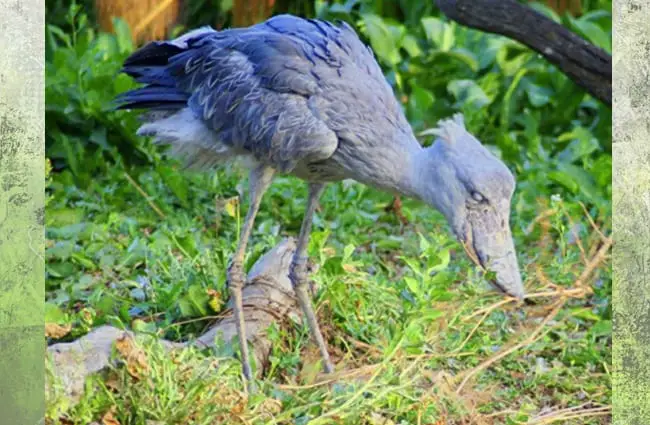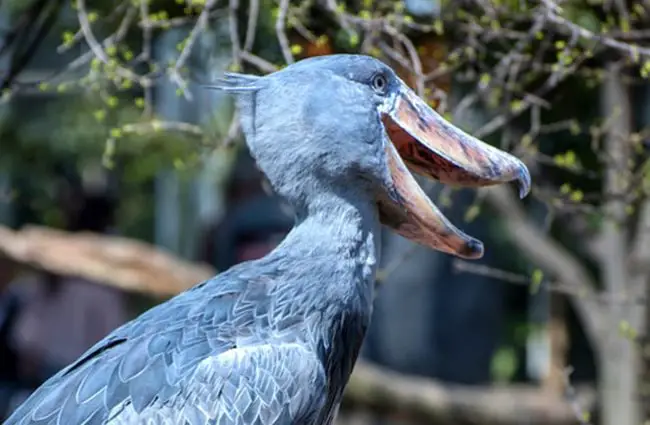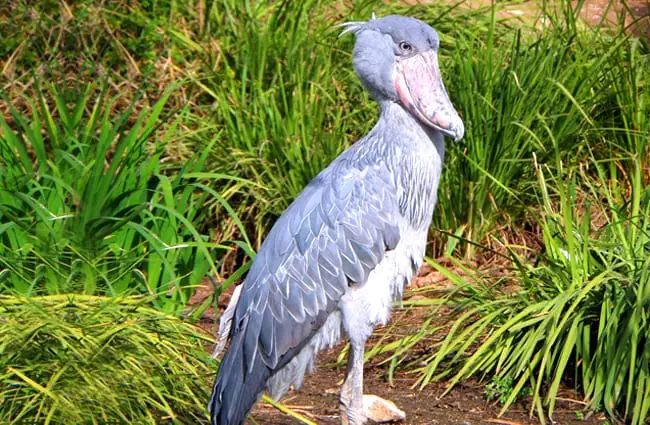In the vast, ancient wetlands of East Africa dwells a bird so peculiar, so utterly unique, that it seems to have stepped right out of the age of dinosaurs. This is the Shoebill Stork, or simply the Shoebill, a creature whose very appearance commands attention and sparks curiosity. With its enormous, shoe-shaped bill and piercing, unblinking gaze, the Shoebill is a living enigma, a master of stealth, and a testament to nature’s boundless creativity. Often described as prehistoric, this magnificent avian marvel offers a window into a world of specialized adaptations and delicate ecological balances.

Unveiling the Shoebill: A General Overview
The Shoebill (Balaeniceps rex) is not just another large bird; it is a taxonomic marvel, a solitary species in its own family, Balaenicipitidae. Its striking features and reclusive nature make it a subject of fascination for birdwatchers and scientists alike.
Appearance: The Iconic Bill and More
The most defining characteristic of the Shoebill is, without a doubt, its massive, shoe-shaped bill. This bill, which can measure up to 24 centimeters (9.4 inches) in length and 10 centimeters (3.9 inches) in width, is grey with darker mottling and features sharp edges and a hooked tip. It is perfectly adapted for its specialized hunting technique. Beyond the bill, the Shoebill is a large, stately bird, standing between 110 to 140 centimeters (43 to 55 inches) tall, with some individuals reaching 152 centimeters (60 inches). Its wingspan can stretch up to 260 centimeters (102 inches). The plumage is a uniform slate-grey, often with a greenish sheen, and its legs are long and dark. Its eyes are large and yellow, contributing to its intense, almost intimidating stare.
Habitat: The Swamps of Africa
Shoebills are inextricably linked to freshwater wetlands across East Africa. Their primary habitat consists of extensive, undisturbed swamps and marshes, particularly those dominated by papyrus and reeds. These birds prefer areas with stagnant or slow-moving water, often interspersed with floating vegetation, which provides both cover and hunting grounds. Their range extends across several countries, including Uganda, South Sudan, eastern Democratic Republic of Congo, Rwanda, western Tanzania, and northern Zambia. Smaller populations can also be found in parts of Ethiopia, Kenya, and the Central African Republic.
Diet and Hunting: The Patient Predator
The Shoebill is a highly specialized piscivore, meaning its diet primarily consists of fish. Its preferred prey includes lungfish, catfish, and tilapia, but it will also consume eels, snakes, frogs, and even small reptiles or young crocodiles. Its hunting strategy is legendary for its patience and precision. The Shoebill often stands motionless for long periods, sometimes up to several hours, resembling a statue amidst the reeds. When prey is spotted, it executes a lightning-fast strike, lunging forward with its massive bill to snatch the unsuspecting victim. The hooked tip of its bill is crucial for decapitating or dismembering its prey before swallowing.

Behavior: Solitary and Silent
Shoebills are largely solitary birds, maintaining vast territories and rarely seen in groups. Even breeding pairs often forage separately. They are known for their quiet demeanor, typically silent except for bill-clattering during nesting or greeting. Their slow, deliberate movements and ability to remain perfectly still contribute to their success as ambush predators. They are most active during the early morning and late evening, avoiding the heat of midday.
Conservation Status: A Vulnerable Future
Sadly, the Shoebill is classified as Vulnerable by the IUCN. Its population is estimated to be between 3,300 and 5,300 mature individuals and is decreasing. The primary threats to its survival are habitat destruction and degradation due to agricultural expansion, drainage of wetlands, and human settlement. Poaching for the illegal pet trade and disturbance by humans also contribute to their decline.
Diving Deeper: The Shoebill’s World
For those eager to delve into the intricacies of this remarkable bird, a closer look reveals even more fascinating details about its evolutionary journey, ecological role, and complex life cycle.
Evolutionary History: A Living Fossil
The Shoebill’s evolutionary lineage is a topic of considerable scientific interest. For a long time, it was classified with storks (Ciconiidae) due to its large size and wetland habitat. However, genetic studies have revealed that the Shoebill is more closely related to pelicans (Pelecanidae) and herons (Ardeidae), belonging to the order Pelecaniformes. Its unique morphology, particularly its specialized bill, suggests a very ancient divergence, making it a “living fossil” in many respects. Its closest living relatives are the pelicans, despite superficial resemblances to storks. This distinct evolutionary path underscores its singular adaptations to its specific ecological niche.
Detailed Habitat Requirements
Shoebills are highly selective about their habitat, requiring specific conditions for survival. They thrive in:
- Extensive Freshwater Swamps: Large, undisturbed areas are crucial to provide sufficient hunting grounds and isolation.
- Dense Vegetation: Papyrus, reeds, and sedges offer camouflage for hunting and protection for nesting.
- Shallow, Stagnant Water: Ideal for their ambush hunting technique, allowing them to stand and wait for prey.
- Proximity to Open Water: While they prefer dense cover, access to open water channels or pools is necessary for foraging.
These specific requirements make them particularly vulnerable to habitat fragmentation and alteration.

Mating and Reproduction: A Harsh Reality
Shoebills are monogamous, forming pairs that defend a large breeding territory.
- Nesting: They build large, flat platform nests, typically 1 to 1.7 meters (3.3 to 5.6 feet) in diameter, made from aquatic vegetation. These nests are usually situated in dense, inaccessible swamp areas, often on floating islands of vegetation.
- Eggs and Incubation: A clutch typically consists of 1 to 3 eggs, which are chalky white. Both parents share incubation duties, which last around 30 days.
- Chick Rearing: The chicks are covered in grey down. While multiple eggs may hatch, it is common for only one chick to survive due to a phenomenon known as siblicide. The older, stronger chick often outcompetes or actively harms its younger siblings, especially during periods of food scarcity. This ensures that at least one chick has the best chance of survival.
- Fledging: Chicks fledge at around 95 to 112 days, but remain dependent on their parents for several weeks or even months after leaving the nest.
Contribution to Ecosystem and Interaction with Other Animals
As an apex predator in its wetland niche, the Shoebill plays a vital role in maintaining the health of its ecosystem.
- Population Control: By preying on fish, snakes, and other small animals, it helps regulate their populations, preventing overgrazing or overpopulation that could destabilize the wetland environment.
- Indicator Species: Due to its specific habitat requirements and sensitivity to disturbance, the Shoebill is considered an indicator species. A healthy Shoebill population often signifies a healthy and intact wetland ecosystem.
- Limited Interactions: Given its solitary nature and large size, the Shoebill has few direct interactions with other large animals. It is generally avoided by other birds and animals due to its imposing presence. Its primary predators, especially for eggs and chicks, include crocodiles and monitor lizards.
Interaction with Humans and Cultural Significance
Human interaction with Shoebills is complex and often fraught with challenges for the bird.
- Threats:
- Habitat Loss: The most significant threat comes from human activities that destroy or degrade wetlands, such as agriculture, cattle grazing, and infrastructure development.
- Disturbance: Human presence, including unregulated tourism and fishing activities, can disturb breeding pairs and foraging birds.
- Poaching: Shoebills are sometimes hunted for food, for their unique bills, or captured for the illegal pet trade, particularly chicks.
- Cultural Contribution: In some local cultures, particularly in Uganda, the Shoebill holds cultural significance. It is sometimes revered as a symbol of good luck or associated with ancestral spirits. Its unique appearance has also made it a popular subject in local folklore and art.

A Huge List of Interesting Facts about Shoebill Stork
- “Whalehead”: Its scientific genus name, Balaeniceps, means “whalehead,” referring to its enormous bill.
- “Death Stare”: Shoebills are known for their intense, unblinking stare, which can last for minutes, giving them a formidable appearance.
- Bill-Clattering: Unlike many storks that are vocal, Shoebills are mostly silent, using bill-clattering as a form of greeting or during nesting.
- Slow Flapping: They have one of the slowest wing flap rates of any bird, around 150 flaps per minute, comparable to larger storks.
- Unique Toes: Their large feet have unwebbed toes, which help them walk on floating vegetation without sinking.
- Cooling Mechanism: Shoebills engage in “gular fluttering,” vibrating the floor of their mouth and throat, to cool themselves down in hot weather.
- Prehistoric Appearance: Their overall look, especially their large head and bill, has earned them comparisons to ancient dinosaurs.
- Master of Camouflage: Their grey plumage blends seamlessly with the dry reeds and papyrus, making them incredibly difficult to spot.
Practical Insights: Engaging with the Shoebill
Whether you are an aspiring zoologist, an avid animal lover, or an accidental encounterer, understanding how to interact responsibly with Shoebills is paramount.
Finding Shoebill Storks in the Wild
For the dedicated animal lover or aspiring zoologist, finding a Shoebill in its natural habitat is a truly rewarding experience.
- Prime Locations: Uganda is often considered the best place, particularly Murchison Falls National Park, Mabamba Bay Wetland, and Semuliki National Park. Other notable locations include Bangweulu Wetlands in Zambia and the Sudd in South Sudan.
- Guided Tours: It is highly recommended to hire experienced local guides who know the specific territories of these elusive birds. Boat safaris through the wetlands are often the most effective way to spot them.
- Timing: Early morning or late afternoon are the best times for sightings, as Shoebills are most active during these cooler periods.
- Patience is Key: Shoebills are masters of stillness. Be prepared to spend long periods quietly observing. Their camouflage is excellent, so look for subtle movements or the distinct silhouette of their bill.
Encountering a Shoebill Stork in the Wild: What to Do
If you are fortunate enough to encounter a Shoebill while hiking or on safari, remember that these are wild, vulnerable animals.
- Maintain Distance: Always keep a respectful distance. Approaching too closely can cause stress to the bird and disrupt its hunting or nesting activities.
- Be Quiet: Shoebills are sensitive to noise. Avoid loud talking, sudden movements, or any actions that might startle them.
- Observe, Do Not Disturb: Your goal should be to observe their natural behavior without influencing it. Do not attempt to feed them, call out to them, or try to attract their attention.
- Follow Guide Instructions: If you are with a guide, always adhere to their instructions, as they are knowledgeable about local wildlife etiquette and safety.

Caring for a Shoebill Stork in Captivity: A Zookeeper’s Guide
Caring for Shoebills in zoos or conservation centers presents unique challenges due to their specialized needs and solitary nature.
- Enclosure Design:
- Spaciousness: Large, expansive enclosures mimicking their natural wetland habitat are essential.
- Water Features: Deep, clean freshwater pools with varying depths and areas of stagnant water are crucial for foraging.
- Vegetation: Dense plantings of reeds, papyrus, and other aquatic vegetation provide cover, nesting material, and a sense of security.
- Substrate: Soft, natural substrates are preferred to protect their feet.
- Diet:
- Specialized Fish: A diet primarily consisting of appropriate fish species (e.g., lungfish, catfish, tilapia) is vital.
- Supplements: Nutritional supplements may be required to ensure a balanced diet, especially for captive-bred fish.
- Live Prey: Offering live fish periodically can provide essential behavioral enrichment and stimulate natural hunting instincts.
- Socialization and Enrichment:
- Solitary Nature: Shoebills are generally solitary. Housing individuals separately or in very large, well-vegetated enclosures where they can avoid each other is often necessary, except for carefully managed breeding pairs.
- Minimal Human Interaction: They are prone to stress from excessive human presence. Keepers should aim for minimal, predictable interactions.
- Enrichment: Providing varied foraging opportunities, different types of vegetation, and occasional introduction of new objects can stimulate their minds and bodies.
- Health Monitoring:
- Foot Care: Regular checks for foot health are important due to their weight and time spent standing.
- Water Quality: Maintaining pristine water quality in their enclosures is critical to prevent infections and skin issues.
- Stress Indicators: Keepers must be vigilant for signs of stress, such as changes in appetite, increased aggression, or unusual behavior.
- Breeding Challenges: Breeding Shoebills in captivity is notoriously difficult due to their specific habitat needs, solitary nature, and the common occurrence of siblicide. Intensive monitoring and intervention may be required to ensure chick survival.
A Glimpse into the Ancient World
The Shoebill Stork stands as a magnificent emblem of the wild, a creature that has defied conventional classification and carved out a unique existence in the heart of Africa’s wetlands. Its prehistoric appearance, specialized hunting techniques, and reclusive nature make it a truly captivating subject. From its evolutionary journey to its critical role in the ecosystem, the Shoebill offers endless opportunities for study and appreciation. Protecting this vulnerable species and its irreplaceable habitat is not just about saving a single bird; it is about preserving a vital piece of our planet’s natural heritage and ensuring that future generations can also marvel at the “whalehead” of the swamps.

![Red Angus Closeup of a beautiful Red Angus cowPhoto by: U.S. Department of Agriculture [pubic domain]https://creativecommons.org/licenses/by/2.0/](https://animals.net/wp-content/uploads/2020/03/Red-Angus-4-238x178.jpg)




![Red Angus Closeup of a beautiful Red Angus cowPhoto by: U.S. Department of Agriculture [pubic domain]https://creativecommons.org/licenses/by/2.0/](https://animals.net/wp-content/uploads/2020/03/Red-Angus-4-100x75.jpg)

